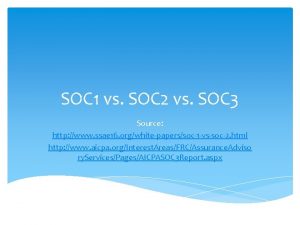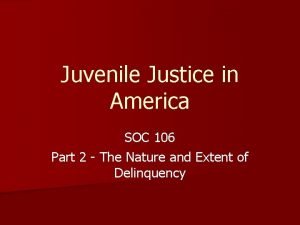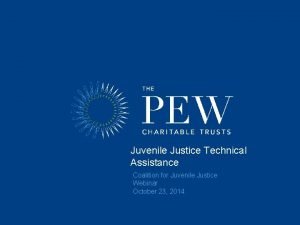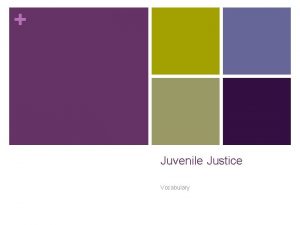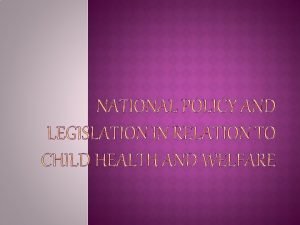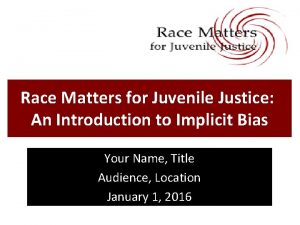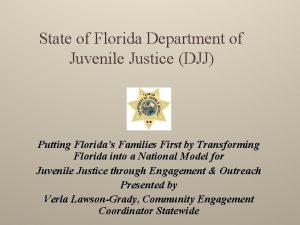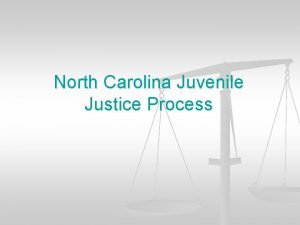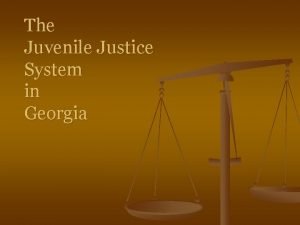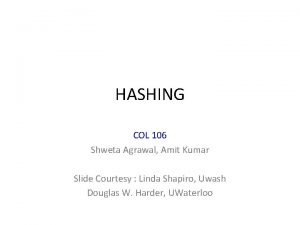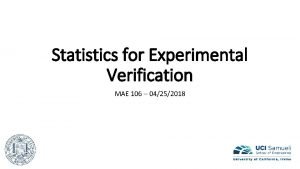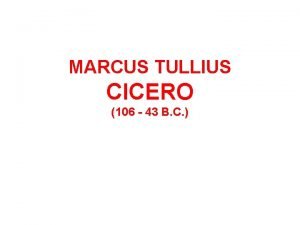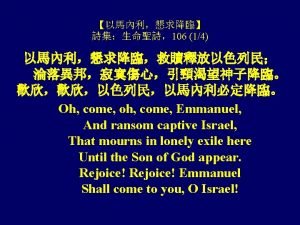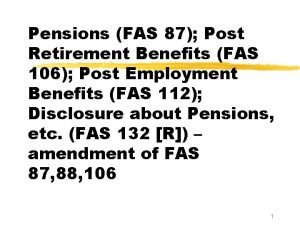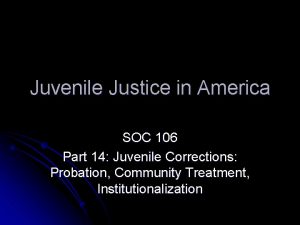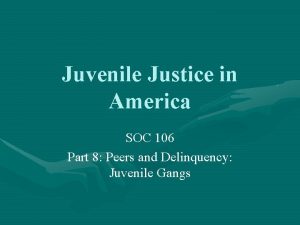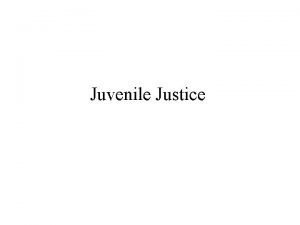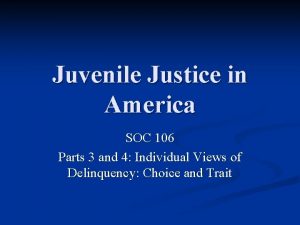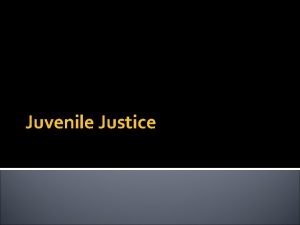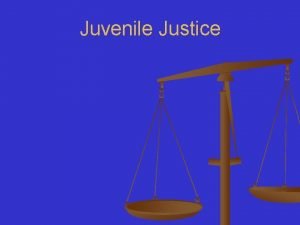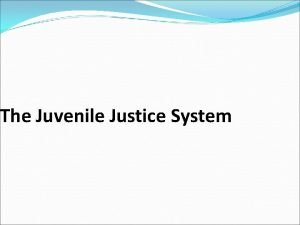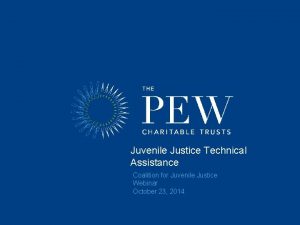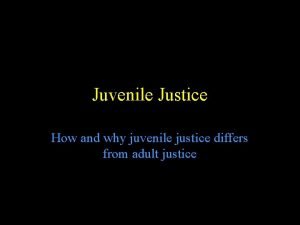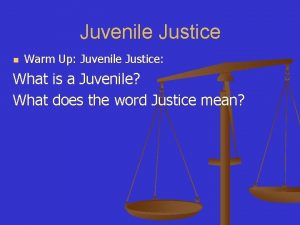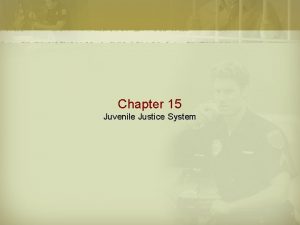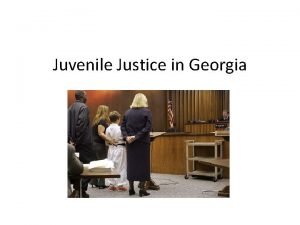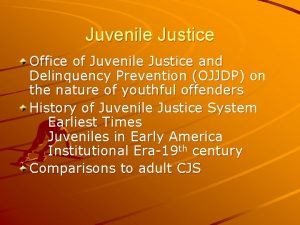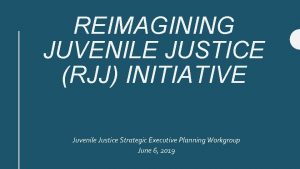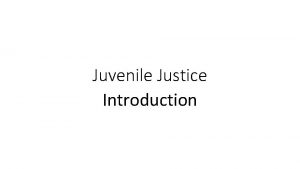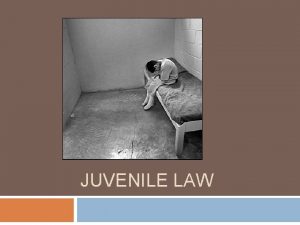Juvenile Justice in America SOC 106 Part 1



























- Slides: 27

Juvenile Justice in America SOC 106 Part 1 – Childhood and Delinquency

1. Evolution of juvenile justice in the 20 th century a. Progressive era - first quarter (1900 – 1925) - “Age of Reform” (1) Progressives believed: - family: influential in child development - parents: bring up child properly - children: be obedient / work hard (2) During this era:

- educated class / in power - feared commoner (a) Poor / working class - destroy society built - lose wealth / status - change lifestyle - personal / business (b) Demanded action - preserve social order - laws / methods enacted - to protect

(3) ‘Medical model’ - earliest theories exploring biological / psychological factors - not fully developed humans (a) Juvenile courts were developing - followed medical model theory - established in Cook Co, Illinois (b) Court knew juvenile need - what considered best - case worker recommendation - closed court system

(5) “Commonwealth vs. Fisher” – 1905 - US Supreme Court - informal: not crimes - file without “due process” (6) Special methods to be used - could be saved - delinquency: preventable / curable (a) Provide support to child - not received from family - school / friends / community

(b) Court jurisdiction - criminal / non-criminal b. First probation officer - good of child - involved: intake / corrections - role: legal / social services (1) Involvement of federal government - “troubled youth” - US Children’s Bureau – 1912 - first child labor laws

(2) Highlights of Progressive Era: (a) Philosophies - transition period - had to be controlled - families: control children - both criminal / socially accepted behaviors - reformed by public effort (family failed) (b) Treatment

- rehabilitation - save delinquent - biological / psychological efforts (c) Policies - juvenile courts - parens patriae: dominant force (continues today) - feds: provide direction 2. New Deal Era - 1920 to 1960

a. Increased turmoil - Great Depression - World War II - Korean Conflict (1) Child welfare subsidies - dependent / neglected / abused / delinquent youth - still in effect: welfare / Social Security - money to needy families with children (2) Juvenile Court Act – 1938

- 5 central philosophies (a) State: “higher or ultimate parent” - can remove children (b) Children worth saving - non-punitive measures (c) Children to be nurtured - not stigmatized (d) Juvenile justice needs to be individual

- background of child - diagnostic evaluation (e) Use of non-criminal procedures are necessary - community programs / treatment / education (f) Despite these efforts: - juvenile delinquency continued to rise

(3) Federal Youth Corrections Act – 1951 - Juvenile Delinquency Bureau - placed under Department of Health, Education, and Welfare - still follows ‘Medical Model’ (a) Washington State - Department of Social / Health Services (b) Treated with expectation of rehabilitating them

b. Highlights of New Deal Era (1) Philosophies - attempt to control / improve social conditions - led back to conformity (2) Treatment - handled by juvenile courts - send to institution for treatment (3) Policies

- federal government broadened role - juvenile courts in all states 3. Great Society Era - 1960 s under President Lyndon Johnson - youth began to rebel / refused to conform - crime / drugs / alternate lifestyle a. Juvenile crime on increase - costing $20 million each year - $17 billion spent over next 6 years to fight delinquency

(1) Spent on delinquency prevention - police / courts / community programs / social services / education / corrections - part of LEAA (Law Enforcement Assistance Administration) (2) To find a “cure, ” money spent on: - sociological services - biological services - psychological services b. Great Society Era produced changes - major impact on juvenile justice

(1) Decriminalization - actions no longer criminal - status offenses vs. criminal offenses (2) Deinstitutionalization - keep offenders out of institutions - keep in community-based programs - near family / school / services - increased use of foster / group homes (3) Diversion - juvenile handled informally by court

- juveniles signed “contract” - community supervision / restitution / some detention time - offense removed from his/her record (4) Due process - most impact on system - given same rights as adults (no jury) - attorney / cross-examine / confront (a) Kent vs. United States – 1966 -transfer to adult court

- serious offense / lengthy record / 16 or 17 years of age - can be “remanded” - end of “socialized justice” (b) Gault vs. Arizona – 1967 - granted due process - same rights as adults c. Changes made in justice system - laws / police / courts / corrections - becoming more formalized

(1) Laws - US Supreme Court has final say - limit actions of courts / police - decisions effect country as a whole (2) Police - deal with juveniles differently - insure rights of juveniles - proper procedures followed - Youth Service Bureaus - trained in juvenile matters - female officers to work with youth

(3) Courts - insure rights of juveniles - juvenile court is primary - judges must be trained - considered a family court (4) Corrections - must provide for juvenile’s treatment - must provide education - must protect all youth d. Highlights of Great Society Era

(1) Philosophy - family / police / courts could not control - major influences (early 1960 s): family / school / church / peer pressure - end of 1960 s: family / peer pressure / school / church - today: peer pressure / family / school / church (2) Treatment - community based therapy - not institutionalization

- keep child in community (3) Policies - federal delinquency grants-in-aid - increase constitutional rights 4. Juvenile justice: 1970 s through today - new concepts / innovations implemented - crime rate continues to increase a. 1970 s - continued the “Four D’s”

- deinstitutionalization / diversion / due process / decriminalization (1) In Re Winship – 1970 - proof beyond a reasonable doubt - before: preponderance of evidence (2) Breed vs. Jones – 1975 - double jeopardy - before: tried twice / more b. 1980 s

- violent crime - gangs / drive-by shootings / drugs (1) Public demands change - laws / policies - interest of society first - over interest of juvenile (2) Time of “deterrence” / “just deserts” - more money into schools / community resources - deter youth from criminal activity

(3) Sentenced to state / local time - built training schools / high-security institutions (a) Juveniles pay for actions - locked up (b) Once incarcerated: - education / training - rehabilitation c. 1990 s

- juvenile crime / violent crime continue - not deterred by “hard core” changes (1) Changing laws / traditions - 16 / 17 year olds to adult courts - Washington state: violent crime (a) Younger juveniles: - remand to adult courts - to adult institutions (b) Expanding detention facilities

- accommodate influx (c) Police procedures also change - more aggressive - DARE / SRO / GREAT - community involvement d. 2000’s - juvenile crime continues to increase - more juveniles tried as adults
 Soc1 and soc2 vs soc3
Soc1 and soc2 vs soc3 Juvenile law definition
Juvenile law definition Coalition for juvenile justice
Coalition for juvenile justice Juvenile justice vocabulary
Juvenile justice vocabulary Juvenile justice act 2000
Juvenile justice act 2000 Race matters for juvenile justice
Race matters for juvenile justice Minnesota juvenile justice system
Minnesota juvenile justice system State of florida department of juvenile justice
State of florida department of juvenile justice North carolina juvenile justice
North carolina juvenile justice Criminal law and juvenile justice unit 2
Criminal law and juvenile justice unit 2 Juvenile justice alternative education program
Juvenile justice alternative education program Juvenile justice system in georgia
Juvenile justice system in georgia Ra. 9344
Ra. 9344 Juvenile justice system georgia
Juvenile justice system georgia What are the branches of criminal justice system
What are the branches of criminal justice system Repetition in let america be america again
Repetition in let america be america again Why called latin america
Why called latin america We can do a rap of the map of the us
We can do a rap of the map of the us Happening body art
Happening body art America vs africa
America vs africa Col 106
Col 106 Sqte-106
Sqte-106 Iat 106
Iat 106 Mae 106 uci
Mae 106 uci Iat 106
Iat 106 Marcus cicero death
Marcus cicero death 生命聖詩 106
生命聖詩 106 Fas 106
Fas 106
